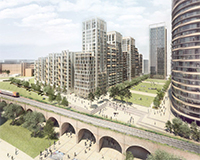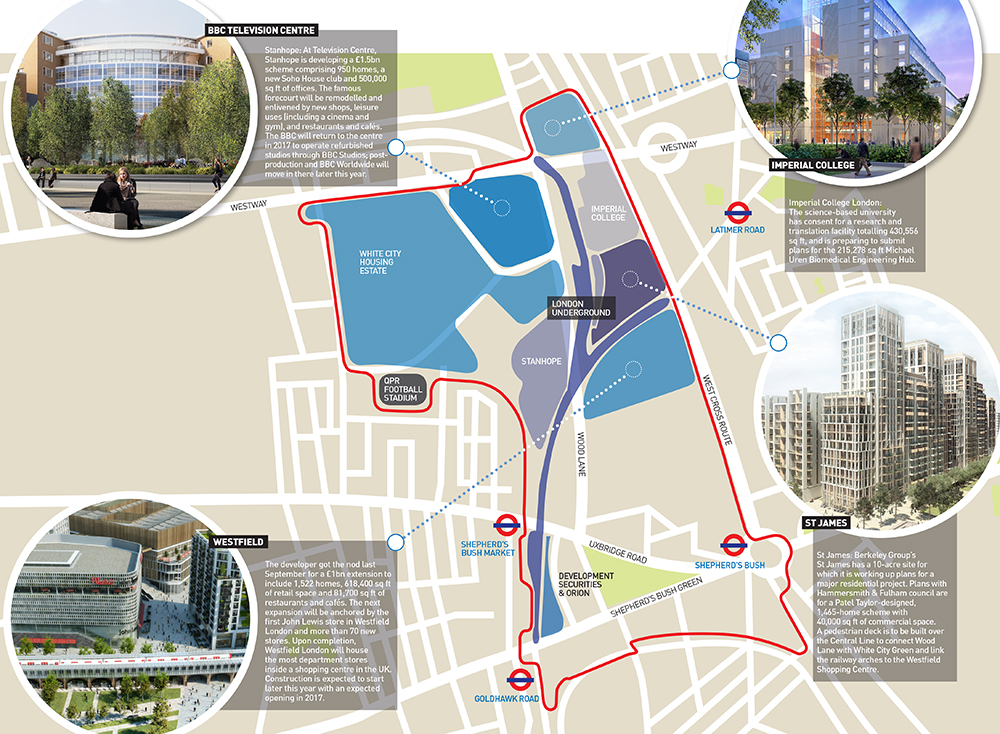Standing on the top floor in a building on the former BBC Television Centre White City campus, Stanhope’s Alistair Shaw points out of the window, through the rain and dark sky, at all the regeneration potential surrounding the broadcasting home, nicknamed “the dream factory”. There is a lot more land and many more redevelopment opportunities than most people would be aware of.
Five major local landowners – Transport for London, Stanhope, Berkeley Group’s St James, Westfield and Imperial College London – have been working together for the first time on a joint regeneration plan. To give an idea of scale, the combined schemes will have an end-value well in excess of £2bn (see map, p12).
It is nearly one year since Shaw was appointed managing director of Stanhope’s BBC Television Centre £1.5bn redevelopment, W12. Since then huge strides have been made at the site, which waved goodbye to the BBC in March 2013.
Over the past 12 months a number of proposals have been either lodged or given consent, and as a result White City will soon be transformed from “not the sort of place you would go to unless you worked there for the BBC” into an area with a stylish Soho House boutique hotel, more than 5,000 new homes, a media village and restaurant quarter.
But just how have the landlords come together and how much will their combined plans boost values in the area?
Shaw, who was previously chief development officer at the Battersea Power Station Development Company, says the White City project and the amount of regeneration being undertaken there is comparable to Nine Elms Battersea on the south side of the river. White City landlords have been meeting every six weeks. “The most important thing, which is crucial to the wider masterplan, is mixed-use buildings,” he says. “Isolation of uses on their own is never as wholesome.”
Coming together with TfL has been an important step. It will be providing access over the tracks between White City and Wood Lane stations to the St James residential scheme and Westfield’s extension. Graeme Craig, TfL’s director of commercial development, says: “Our role is very much about making the best use of space we have as a gateway to these new schemes.”
Duncan Bower, director of development at Westfield, says: “All stakeholders are working to make this a joined-up vision for White City rather than a series of large but discrete projects. The combination of retail, leisure, education, homes and offices will make Shepherd’s Bush and White City a major mixed-use destination contributing to the economic buoyancy of Hammersmith & Fulham and west London.”
Joining forces has allowed the combined group to be a destination-maker, but making a profit is obviously a priority as well. In working together the landlords will no doubt be hoping that a joint strategy, synergy between the schemes and a cluster of uses will make the area more firmly a destination. Improving the attractiveness of the area as a whole has got to be good for values.
So confident of the power of office potential at White City was Stanhope that last year it increased the overall volume of planned office space at the scheme, from 350,000 sq ft to 519,000 sq ft. Shaw believes that existing rents of around £28 per sq ft will soar to close to £50 per sq ft by the time the new stock is delivered.
And the £50 per sq ft figure seems a realistic one. Michael Pain, partner and head of tenant advisory at Carter Jonas, has also forecast rents of that amount for the area.
Pain explains: “Over the next five years I would expect White City office rents to align closer with those in Hammersmith as regeneration initiatives turn the ‘ugly duckling’ of the west London commercial property market into an attractive, vibrant area in which to live, work and spend leisure time.”
Shaw adds that Stanhope is already “getting a knock on the door from serious occupiers seeking places at the site”.
As well as office rental growth, Carter Jonas expects residential values to jump. Homes feature in plans by Westfield, BBC and St James.
Tim Shaw, head of central London development at Carter Jonas, says: “White City is undergoing significant regeneration and we expect capital values to substantially increase in the future. We note the similarities of the area to the Vauxhall Nine Elms Battersea Opportunity Area.
He adds that residential values will move well above £1,000 per sq ft with the best flats in new schemes achieving in excess of £2,000 per sq ft.
The figures are much higher than the £888 per sq ft achieved on nearby new homes.
Westfield’s Bower, who is overseeing a retail expansion that will be anchored by the first John Lewis store in Westfield London, says: “When we started work there in 2004, the Wood Lane area comprising industrial and infrastructure uses was generally not the sort of place you would go to unless you worked for the BBC. But the transformation has been huge and intense.”
With the combination of a world-class university, the return of some BBC divisions, as well as homes, offices and shops, White City will become truly mixed-use and be able to regain its “dream factory” title.

Lessons from Nine Elms
Councillor Ravi Govindia, leader of Wandsworth council, has some advice for all people involved in White City after seeing major landlord collaboration in his own constituency.
Govindia says: “The clear message for joined-up major redevelopment projects is that there needs to be a meeting of minds. A real amount of commitment and effort is required from landowners – and making sure that all pull their weight. For councils it is also about leadership and commitment and overall belief in the final scheme. They need to have trust in the landlords.”












